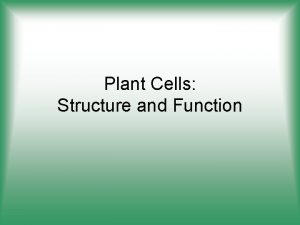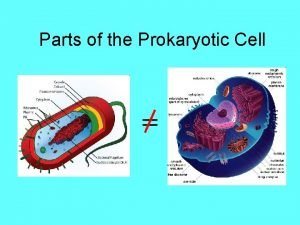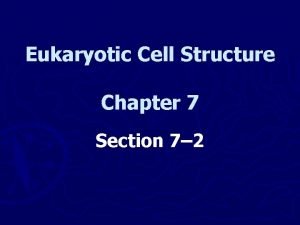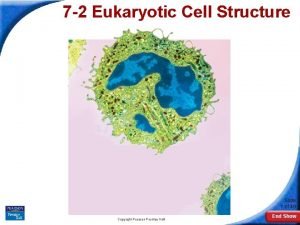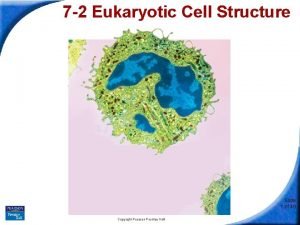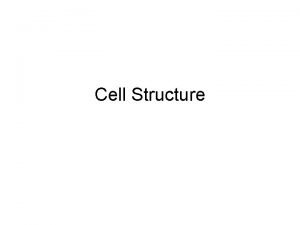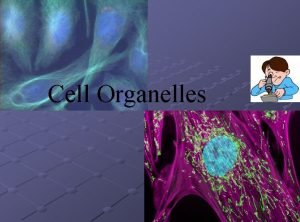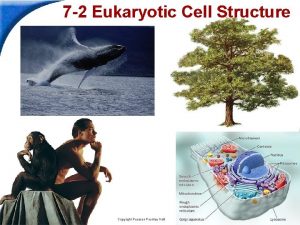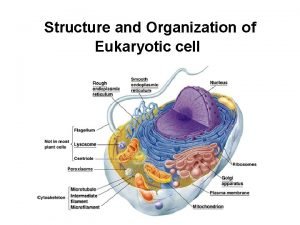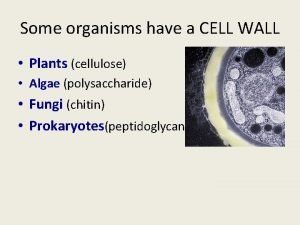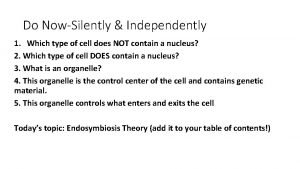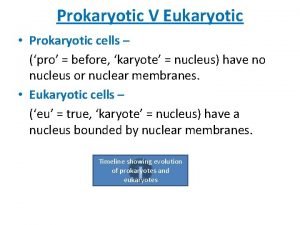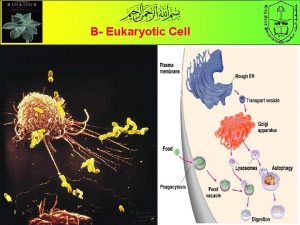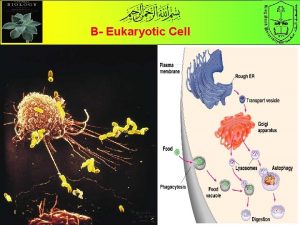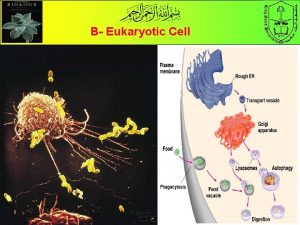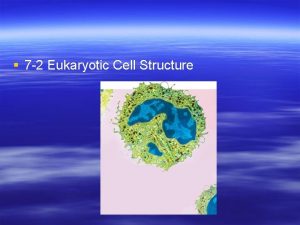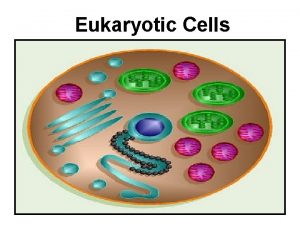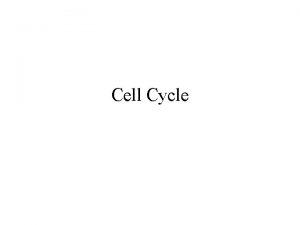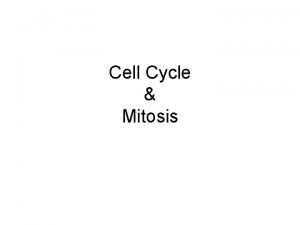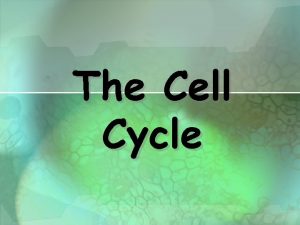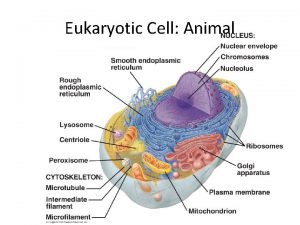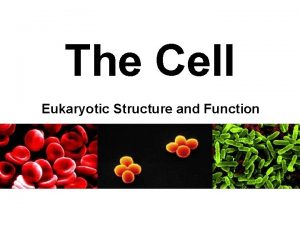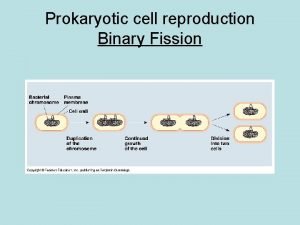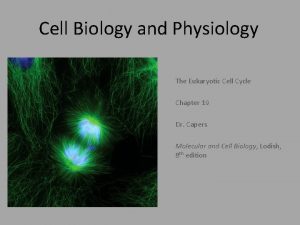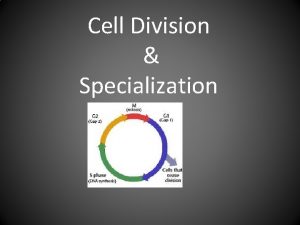The Cell Cycle The Cell Cycle of Eukaryotic






















- Slides: 22

The Cell Cycle

The Cell Cycle of Eukaryotic Cells � Cell cycle – regular pattern of eukaryotic cells that includes growth, DNA replication and cell division � All eukaryotic cells go through the same basic cycle � Essential � If for organism growth and healing cycle is uncontrolled or incorrect disease will result

4 Main Phases of the Cell Cycle 1. Gap 1 (aka Growth 1) 2. S phase – “S” for synthesis 3. Gap 2 (aka Growth 2) 4. M phase – “M” for mitosis Interphase


ØCell carries out normal functions ØCell growth • Increases in size • Cellular contents, excluding chromosomes, are duplicated ØMajority of cell cycle is spent in this phase ØThere is a checkpoint in this phase (Why? ) • If cell has adequate nutrition, proper size, undamaged DNA and organism requires more cells it will proceed to next phase! • If an organism doesn’t require more cells it may enter G 0 at this time.

Ø Synthesis Ø Cell – to make or to put together copies the DNA in the nucleus �Semi-conservative replication… �At end of this phase the cell contains 2 copies of DNA! Each of the 46 chromosomes is duplicated. �The copies are attached to each other and are both inside 1 nucleus

ØCell carries out normal functions ØAdditional cell growth ØThere is a check point in this phase (Why? ) – the cell “double checks” the duplicated chromosomes for error, making any needed repair. If cell has adequate nutrition, proper size, undamaged DNA and organism requires more cells it will proceed to next phase!

2 (possible) parts ØMitosis – division of the cell nucleus and its contents v. Also called karyokinesis – the division of the nucleus v. Kinesis – Greek for movement, to move ØCytokinesis – division of the cell cytoplasm v. Usually follows mitosis but not always!

ØNuclear membrane dissolves Ø 2 sets of DNA separate �Remember, we copied this during S phase ØNew nuclear membranes form around each set of DNA separately � 2 nuclei! �(nuclei is plural of nucleus)

ØDivision of cytoplasm Ø 1 cell divided in half resulting in 2 “new” cells • Original cell is called ‘parent’ cell • 2 new cells are called ‘daughter’ cells ØEach daughter cell gets one of the nuclei • Each has a copy of DNA – identical copy • Carbon copy of original parent cell


Not a real phase in the cell cycle Ø Phase name for cells that rarely divide or in which cell division has stopped v. Some stay in stage until more cells of that type are needed. �Lymphocyte (type of white blood cell) - fight disease, only reproduce when needed v. Some stay in stage permanently �Neurons (nerve cells) – neuroglial cells DO divide �Skeletal and cardiac muscle cells Ø Nerve cells and skeletal muscle cells cannot undergo mitosis after they fully develop. This is why nerve and muscle diseases are so debilitating.

Ø Cells divide at different rates • Prokaryotic cells divide much faster than eukaryotic cells (Why? ) • Cells in embryos and children divide much faster than in adults (Why? ) Ø Differs according to cell/tissue types • More wear and tear – faster division and replacement • May only divide and replace as result of cell injury or cell death In humans, 50 million cells die every second!

Cells divide to produce more cells as body needs them In humans – length of G 1 varies with cell type but S + G 2 + M = 12 hours!

ØToo small can not contain all needed organelles and molecules ØToo big becomes a problem of adequate exchange of materials and transport of those materials within cell �Nutrients and waste move across cell membrane – surface area must be large enough to handle needed amounts

ØFor cells to stay the same size from generation to generation, growth and cell division must be coordinated ØNeed large surface area with relatively small volume �Surface: volume ratio = the bigger the ratio the better Analogy: Think of baking one large cake v 3 smaller ones

Ø Apoptosis – programmed cell death; the process by which a cell will kill itself through internal proteases and nucleases. It can be triggered by a number of internal or external signals.

Ø Ø Ø Internal signal examples: if the DNA of a cell is damaged to a degree where the cell is unable to repair itself mechanisms will signal the cell to kill itself, in order to prevent cancerous transformation. The cells that form webbed digits in a fetus undergo apoptosis in order to have individualized fingers and toes. External signal examples: if a neuron during development fails to form the correct connections to other cells, it will initiate apoptosis (90% of all neurons formed during development do this). Alternatively, if a cell finds itself on the "wrong" sort of extracellular matrix proteins (meaning it is in the wrong location in the body), it will apoptose (this is called "anoikis"). Signaling proteins can also tell a cell to kill itself: if an immune cell encounters a virus-infected cell, it will tell the infected cell to commit suicide. Apoptosis can also occur inappropriately. For example, Huntington's disease is caused when a subset of neurons undergo apoptosis when they should not.

Ø Cancer - abnormal and uncontrolled cell division Ø 2 possibilities: • A mutation occurs within the cell causing normal cell cycle controls and check points to fail • A normal cell embedded in a benign growth is starved of oxygen, but it can survive by switching to glycolysis for energy (recall that glycolysis is anaerobic). In this process, the mitochondria, which holds the cell’s selfdestruct mechanism is turned off. This makes the cell “immortal” and cancerous, so it continues to replicate, and the tumor grows. Glycolysis also generates lactic acid which lets the cancer cells eat through tissue, escape, and form secondary cancers elsewhere in the body.



 Prokaryotic vs eukaryotic cell
Prokaryotic vs eukaryotic cell Prokaryotic cell and eukaryotic cell similarities
Prokaryotic cell and eukaryotic cell similarities Life
Life Eukaryotic cell animal cell
Eukaryotic cell animal cell Prokaryotic cells vs. eukaryotic cells
Prokaryotic cells vs. eukaryotic cells Plant cell
Plant cell Amoeba prokaryotic or eukaryotic
Amoeba prokaryotic or eukaryotic Eukaryotic cell structure
Eukaryotic cell structure Section 7-2 eukaryotic cell structure
Section 7-2 eukaryotic cell structure Biology chapter 7 cell structure and function
Biology chapter 7 cell structure and function Typical eukaryotic cell
Typical eukaryotic cell 7-2 eukaryotic cell structure
7-2 eukaryotic cell structure Section 7-2 eukaryotic cell structure
Section 7-2 eukaryotic cell structure Eukaryotic cell organisation
Eukaryotic cell organisation Difference between prokaryote and eukaryotes
Difference between prokaryote and eukaryotes Section 7-2 eukaryotic cell structure
Section 7-2 eukaryotic cell structure Fungi locomotion present or absent
Fungi locomotion present or absent Are cell walls prokaryotic or eukaryotic
Are cell walls prokaryotic or eukaryotic Are cell walls prokaryotic or eukaryotic
Are cell walls prokaryotic or eukaryotic Plants are multicellular eukaryotes
Plants are multicellular eukaryotes Eukaryotic cell questions
Eukaryotic cell questions Cell organelle
Cell organelle Difference between prokaryotic and eukaryotic
Difference between prokaryotic and eukaryotic





